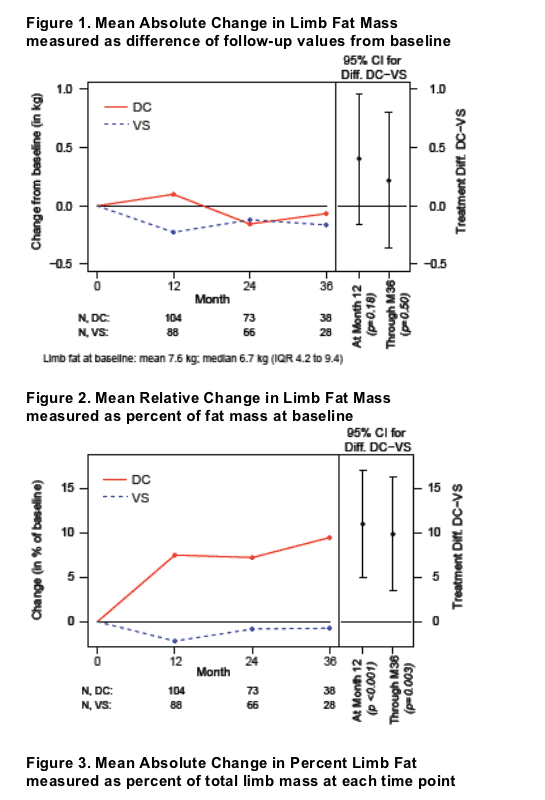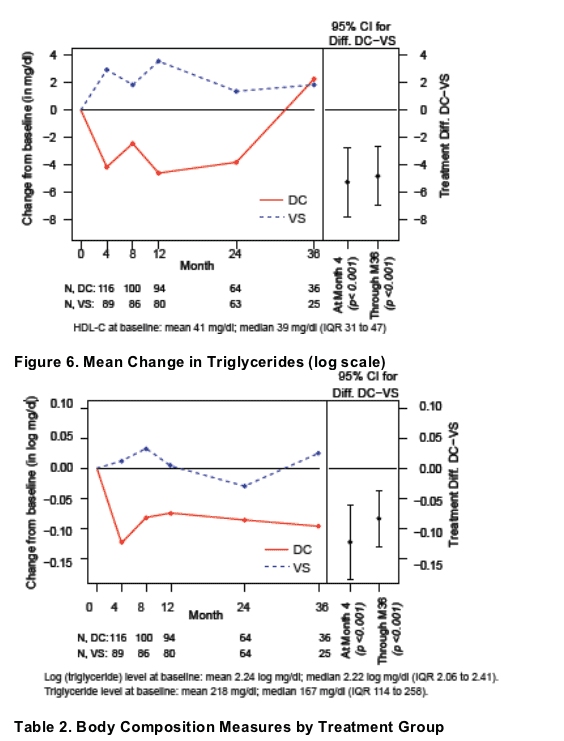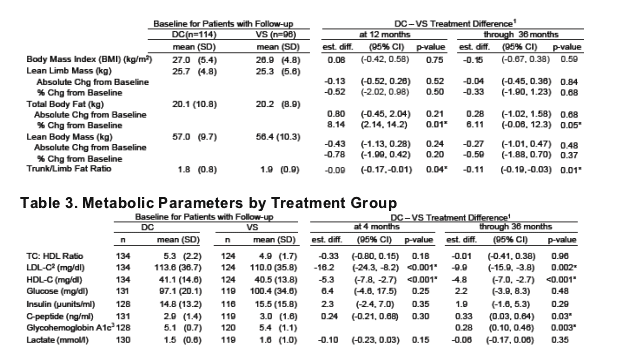 |
 |
 |
| |
The Effects of Intermittent, CD4-Guided Antiretroviral Therapy on Peripheral Limb Fat and Metabolic Parameters:
The SMART Body Composition Substudy
|
| |
| |
Reported by Jules Levin
CROI, Feb 2007, Los Angeles
Fehmida Visnegarwala1, Birgit Grund2, Avis Thomas2, Kenneth Ellis1, Cynthia Gibert3, Judith Shlay4, Fraser Drummond5, Esteban Martinez6, Peter Reiss7, Daniel Pearce8,
Simon Edwards9, Wafaa El-Sadr10, Andrew Carr11, and the Body Composition Substudy Investigators of the Strategies for Management of Anti-Retroviral Therapy (SMART) Study.
1Baylor College of Med, Houston, TX, USA; 2University of Minnesota, Minneapolis, USA; 3Veterans Affairs Medical Center, Washington, DC, USA; 4Denver CPCRA, Denver Public Health, University of Colorado Health Sciences Center, Denver, USA;
5National Centre in HIV Epidemiology and Clinical Research, University of New South Wales, Sydney, Australia; 6Hospital Clinic, Institut d'Investigacions Biomediques August Pi i Sunyer, University of Barcelona, Spain; 7National AIDS Therapy Evaluation Center (NATEC), Academic Medical Center,
Amsterdam, The Netherlands; 8AltaMed Health Services, Los Angeles, USA; 9Mortimer Market Centre, University College Hospital, London, United Kingdom; 10Harlem Hospital and Columbia University, New York, USA; 11St.Vincent's Hospital, University of New South Wales, Sydney, Australia
Introduction
- Antiretroviral Therapy (ART) is commonly associated with lipodystrophy (LD),
atherogenic dyslipidemia, insulin resistance, type 2 diabetes and lactic acidemia.
- Among the limited options for the management of LD the most proven intervention is switching off thymidine analogue nucleoside reverse transcriptase inhibitors (tNRTI), but the improvement is slow and incomplete.
- Interruption of ART has been used to mitigate these body fat and metabolic changes. However, this strategy has not been evaluated in a randomized trial.
- We evaluated the effect of intermittent, CD4-guided ART compared to continuous ART on body composition changes in a subset of patients enrolled in the Strategies for Management of Antiretroviral Therapy (SMART) study.1
- SMART is a large international randomized trial; patients with CD4+ lymphocyte
counts >350 cells/mm3 were randomized to intermittent, CD4-guided ART (stop or defer ART until CD4 < 250 cells/mm3, then use ART until CD4 > 350 cells/mm3) (Drug Conservation [DC] group) or to continuous ART (Viral Suppression [VS] group). On 11 January 2006, the DC strategy was stopped due to increased risk of opportunistic disease and all-cause death.
Methods
Study Population:
- Between May 2002 and January 2006, participants from 32 clinical sites (10
radiology sites) in the US, Australia and Spain were co-enrolled in the SMART Body Composition substudy.
- Eligibility criteria included written, informed consent, and the ability to undergo imaging procedures.
Dual-Energy X-Ray Absorptiometry (DEXA):
- Total body DEXA was performed at baseline and annually (fat and lean mass).
- The scanning protocol was standardized across all radiology sites. Scan images were read centrally.
Metabolic Parameters:
- Fasting (≥8 hours) metabolic parameters were assessed at baseline, months 4, 8 and 12, and then annually.
Analysis:
- Comparisons of the randomized groups used longitudinal mixed models, adjusted for sex, race, and baseline values. Change in fat mass was measured as difference from baseline fat mass (absolute change) and as % of baseline fat mass (relative change).
- Data were censored on 11 January 2006.

By 4 months, 20% of patients in the DC group had re-initiated ART, and 44% by
12 months.
Changes in limb fat from baseline to month 36 are presented in Figures 1-3, for 3
outcomes.
A modest between-group benefit for limb fat was seen in the DC group at month 12, although differences appeared to attenuate thereafter.
Among patients who were taking ART at study entry (74%), the DC vs. VS treatment difference in limb fat change was statistically significant (p < 0.05) at month 12 and through month 36 for all 3 outcomes. Among patients who entered the study off ART, treatment differences in limb fat were not statistically significant, but the sample size was small and thus the tests had low power.
Changes in secondary endpoints are shown in Figures 4-6 and Tables 2-3. There
were significant reductions in lipids in DC relative to VS starting at month 4. There was no significant difference observed for glucose, insulin, C-peptide and lactic acid at month 4. Through month 36, changes in C-peptide and
glycohemoglobin A1c were significantly different between the two groups.
AUTHOR CONCLUSIONS
Compared to continuous ART, use of intermittent, CD4-guided ART modestly improved peripheral fat at 12 months.
The changes observed do not appear to be greater than the increase observed after discontinuation of tNRTIs. However, switching off tNRTIs in the VS arm may have contributed to the attenuation of the differences between the two arms.
The apparent decrease in benefit over time may be related to reinstitution of ART in the DC group, and the lower numbers of patients at months 24 and 36.
Intermittent, CD4 guided ART is associated with lowering of all lipids - thus the
effect on cardiovascular risk is uncertain because both total and HDL cholesterol
levels declined.
Changes to month 12 are consistent with lipid changes observed in the main SMART study.2 In addition, our data highlight the rapidity of decline in lipids
(within 4 months) with the intermittent CD4 guided ART.
Changes in most of the glycemic parameters by 4 months were not significantly
different between the two groups.




|
| |
|
 |
 |
|
|